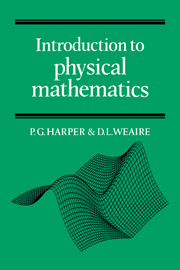Book contents
- Frontmatter
- Contents
- Preface
- Some notes on notation
- 1 Introduction
- 2 Errors
- 3 Cartesian coordinates
- 4 Vectors
- 5 The scalar product
- 6 The vector product and rotation
- 7 Matrices in physics
- 8 The transformation of matrices
- 9 The matrix eigenvalue equation
- 10 Exponential and logarithm functions
- 11 Sine and cosine functions
- 12 Graph plotting and curve sketching
- 13 Differentiation
- 14 Approximations
- 15 Power series and Taylor's expansion
- 16 Partial differentiation
- 17 Integration
- 18 The differential equation
- 19 Solving first-order differential equations
- 20 Second-order differential equations
- 21 Solving second-order differential equations
- 22 The complex exponential
- 23 The circuit equation
- 24 Harmonics and Fourier series
- 25 The diffusion equation
- 26 Waves
- 27 The rate of change of a vector
- 28 The scalar field and gradient operator
- 29 The vector field
- 30 Line integration
- 31 The potential field
- 32 Surface and volume integration
- 33 Flux and divergence
- 34 Circulation and the curl
- 35 Conclusion
- 36 Miscellaneous exercises
- Index
24 - Harmonics and Fourier series
Published online by Cambridge University Press: 20 October 2009
- Frontmatter
- Contents
- Preface
- Some notes on notation
- 1 Introduction
- 2 Errors
- 3 Cartesian coordinates
- 4 Vectors
- 5 The scalar product
- 6 The vector product and rotation
- 7 Matrices in physics
- 8 The transformation of matrices
- 9 The matrix eigenvalue equation
- 10 Exponential and logarithm functions
- 11 Sine and cosine functions
- 12 Graph plotting and curve sketching
- 13 Differentiation
- 14 Approximations
- 15 Power series and Taylor's expansion
- 16 Partial differentiation
- 17 Integration
- 18 The differential equation
- 19 Solving first-order differential equations
- 20 Second-order differential equations
- 21 Solving second-order differential equations
- 22 The complex exponential
- 23 The circuit equation
- 24 Harmonics and Fourier series
- 25 The diffusion equation
- 26 Waves
- 27 The rate of change of a vector
- 28 The scalar field and gradient operator
- 29 The vector field
- 30 Line integration
- 31 The potential field
- 32 Surface and volume integration
- 33 Flux and divergence
- 34 Circulation and the curl
- 35 Conclusion
- 36 Miscellaneous exercises
- Index
Summary
Musicians, whether they saw, hammer or blow, are all acquainted with overtones. The octave of a note simply doubles the frequency (or very nearly, for the well-tempered piano) and coincides with its first overtone. An octave plus a (major) fifth trebles the frequency and defines the second overtone, and so on. A single sustained note (unless produced by a good tuning fork) actually contains many such overtones, a fact musically exploited by the harmonies of Claude Debussy. The richness and quality of a musical note depends very much upon its tonal content.
The Greeks, first in the field as so often, developed the arithmetic of tonal or harmonic perfection, incorporating it even into architecture and their ideas concerning the motion of the planets. However, the mathematics of modern harmonic theory is largely due to Joseph Fourier (1768–1830) who used it in his treatise on the propagation of heat. Fourier's idea was to represent a function by a series of sine (and cosine) functions. Although wave motion (with its acoustic applications) and diffusion (with its thermal applications) are mathematically described by different equations (see chapters 25,26), both may be solved in a very general way by the method of Fourier.
As well as these two areas of physics, Fourier analysis turns up characteristically in the description of electrical signals.
- Type
- Chapter
- Information
- Introduction to Physical Mathematics , pp. 165 - 172Publisher: Cambridge University PressPrint publication year: 1985

